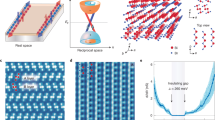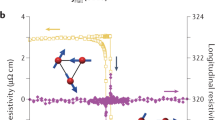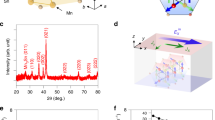Abstract
Quantum anomalous Hall (QAH) systems are of great fundamental interest and potential application because of their dissipationless conduction without the need for an external magnetic field1,2,3,4,5,6,7,8,9. The QAH effect has been realized in magnetically doped topological insulator thin films10,11,12,13,14. However, full quantization requires extremely low temperature (T < 50 mK) in the earliest works, athough it has been significantly improved by modulation doping or co-doping of magnetic elements15,16. Improved ferromagnetism has been shown in these thin films, yet direct evidence of long-range ferromagnetic order is lacking. Herein, we present direct visualization of long-range ferromagnetic order in thin films of Cr and V co-doped (Bi,Sb)2Te3 using low-temperature magnetic force microscopy with in situ transport. The magnetization reversal process reveals typical ferromagnetic domain behaviour—that is, domain nucleation and possibly domain wall propagation—in contrast to much weaker magnetic signals observed in the endmembers, possibly due to superparamagnetic behaviour17,18,19. The observed long-range ferromagnetic order resolves one of the major challenges in QAH systems, and paves the way towards high-temperature dissipationless conduction by exploring magnetic topological insulators.
This is a preview of subscription content, access via your institution
Access options
Access Nature and 54 other Nature Portfolio journals
Get Nature+, our best-value online-access subscription
$29.99 / 30 days
cancel any time
Subscribe to this journal
Receive 12 print issues and online access
$209.00 per year
only $17.42 per issue
Buy this article
- Purchase on Springer Link
- Instant access to full article PDF
Prices may be subject to local taxes which are calculated during checkout




Similar content being viewed by others
References
Haldane, F. D. M. Model for a quantum Hall effect without Landau levels: condensed-matter realization of the ‘parity anomaly’. Phys. Rev. Lett. 61, 2015–2018 (1988).
Onoda, M. & Nagaosa, N. Quantized anomalous Hall effect in two-dimensional ferromagnets: Quantum Hall effect in metals. Phys. Rev. Lett. 90, 206601 (2003).
Liu, C. X., Qi, X. L., Dai, X., Fang, Z. & Zhang, S. C. Quantum anomalous Hall effect in Hg1−yMn1−yTe quantum wells. Phys. Rev. Lett. 101, 146802 (2008).
Qi, X. L., Hughes, T. L. & Zhang, S. C. Topological field theory of time-reversal invariant insulators. Phys. Rev. B 78, 195424 (2008).
Yu, R. et al. Quantized anomalous Hall effect in magnetic topological insulators. Science 329, 61–64 (2010).
Qiao, Z. H. et al. Quantum anomalous Hall effect in graphene from Rashba and exchange effects. Phys. Rev. B 82, 161414 (2010).
Nomura, K. & Nagaosa, N. Surface-quantized anomalous Hall current and the magnetoelectric effect in magnetically disordered topological insulators. Phys. Rev. Lett. 106, 166802 (2011).
Zhang, H., Lazo, C., Bluegel, S., Heinze, S. & Mokrousov, Y. Electrically tunable quantum anomalous Hall effect in graphene decorated by 5d transition-metal adatoms. Phys. Rev. Lett. 108, 056802 (2012).
Ezawa, M. Valley-polarized metals and quantum anomalous Hall effect in silicene. Phys. Rev. Lett. 109, 055502 (2012).
Chang, C.-Z. et al. Experimental observation of the quantum anomalous Hall effect in a magnetic topological insulator. Science 340, 167–170 (2013).
Checkelsky, J. G. et al. Trajectory of the anomalous Hall effect towards the quantized state in a ferromagnetic topological insulator. Nat. Phys. 10, 731–736 (2014).
Kou, X. et al. Scale-invariant quantum anomalous Hall effect in magnetic topological insulators beyond the two-dimensional limit. Phys. Rev. Lett. 113, 137201 (2014).
Kou, X. et al. Metal-to-insulator switching in quantum anomalous Hall states. Nat. Commun. 6, 8474 (2015).
Feng, Y. et al. Observation of the zero Hall plateau in a quantum anomalous Hall insulator. Phys. Rev. Lett. 115, 126801 (2015).
Mogi, M. et al. Magnetic modulation doping in topological insulators toward higher-temperature quantum anomalous Hall effect. Appl. Phys. Lett. 107, 182401 (2015).
Ou, Y. et al. Enhancing the quantum anomalous Hall effect by magnetic codoping in a topological insulator. Adv. Mater. 30, 1703062 (2018).
Lachman, E. O. et al. Visualization of superparamagnetic dynamics in magnetic topological insulators. Sci. Adv. 1, e1500740 (2015).
Grauer, S. et al. Coincidence of superparamagnetism and perfect quantization in the quantum anomalous Hall state. Phys. Rev. B 92, 201304 (2015).
Lee, I. et al. Imaging Dirac-mass disorder from magnetic dopant atoms in the ferromagnetic topological insulator Crx(Bi0.1Sb0.9)2−xTe3. Proc. Natl Acad. Sci. USA 112, 1316–1321 (2015).
Bednorz, J. G. & Muller, K. A. Possible high T c superconductivity in the Ba–La–Cu–O system. Z. Phys. B 64, 189–193 (1986).
Wu, M. K. et al. Superconductivity at 93 K in a new mixed-phase Y–Ba–Cu–O compound system at ambient pressure. Phys. Rev. Lett. 58, 908–910 (1987).
Maeda, H., Tanaka, Y., Fukutomi, M. & Asano, T. A new high-Tc oxide superconductor without a rare earth element. Jpn J. Appl. Phys. 27, L209–L210 (1988).
Schilling, A., Cantoni, M., Guo, J. D. & Ott, H. R. Superconductivity above 130 K in the Hg–Ba–Ca–Cu–O system. Nature 363, 56–58 (1993).
Chang, C. Z. et al. High-precision realization of robust quantum anomalous Hall state in a hard ferromagnetic topological insulator. Nat. Mater. 14, 473–477 (2015).
Grauer, S. et al. Scaling of the quantum anomalous Hall effect as an indicator of axion electrodynamics. Phys. Rev. Lett. 118, 246801 (2017).
Chang, C.-Z. et al. Chemical-potential-dependent gap opening at the Dirac surface states of Bi2Se3 induced by aggregated substitutional Cr atoms. Phys. Rev. Lett. 112, 056801 (2014).
Li, W. et al. Origin of the low critical observing temperature of the quantum anomalous Hall effect in V-doped (Bi,Sb)2Te3 film. Sci. Rep. 6, 32732 (2016).
Anderson, P. W. Absence of diffusion in certain random lattices. Phys. Rev. 109, 1492–1505 (1958).
Andriotis, A. N. & Menon, M. Defect-induced magnetism: Codoping and a prescription for enhanced magnetism. Phys. Rev. B 87, 155309 (2013).
Qi, S. F. et al. High-temperature quantum anomalous Hall effect in n–p codoped topological insulators. Phys. Rev. Lett. 117, 056804 (2016).
Nagaosa, N., Sinova, J., Onoda, S., MacDonald, A. H. & Ong, N. P. Anomalous Hall effect. Rev. Mod. Phys. 82, 1539–1592 (2010).
Ruderman, M. A. & Kittel, C. Indirect exchange coupling of nuclear magnetic moments by conduction electrons. Phys. Rev. 96, 99–102 (1954).
Kou, X. F. et al. Interplay between different magnetisms in Cr-doped topological insulators. ACS Nano 7, 9205–9212 (2013).
Wang, W., Chang, C.-Z., Moodera, J. S. & Wu, W. Visualizing ferromagnetic domain behavior of magnetic topological insulator thin films. npj Quant. Mater. 1, 16023 (2016).
Li, M. et al. Experimental verification of the Van Vleck nature of long-range ferromagnetic order in the vanadium-doped three-dimensional topological insulator Sb2Te3. Phys. Rev. Lett. 114, 146802 (2015).
Li, H. et al. Carriers dependence of the magnetic properties in magnetic topological insulator Sb1.95−xBixCr0.05Te3. Appl. Phys. Lett. 101, 072406 (2012).
Checkelsky, J. G., Ye, J., Onose, Y., Iwasa, Y. & Tokura, Y. Dirac-fermion-mediated ferromagnetism in a topological insulator. Nat. Phys. 8, 729–733 (2012).
Sessi, P. et al. Signatures of Dirac fermion-mediated magnetic order. Nat. Commun. 5, 5349 (2014).
Chang, C.-Z. et al. Zero-field dissipationless chiral edge transport and the nature of dissipation in the quantum anomalous Hall state. Phys. Rev. Lett. 115, 057206 (2015).
Wang, W. et al. Visualizing weak ferromagnetic domains in multiferroic hexagonal ferrite thin film. Phys. Rev. B 95, 134443 (2017).
Wang, W. et al. Visualizing ferromagnetic domains in magnetic topological insulators. APL Mater. 3, 083301 (2015).
Rugar, D. et al. Magnetic force microscopy: General principles and application to longitudinal recording media. J. Appl. Phys. 68, 1169–1183 (1990).
Acknowledgements
We thank C. Chang for helpful discussions and P. Sass for proofreading the manuscript. This work at Rutgers is supported by the Office of Basic Energy Sciences, Division of Materials Sciences and Engineering, US Department of Energy under Award numbers DE-SC0008147 and DE-SC0018153. The work at Tsinghua University is supported by the National Natural Science Foundation of China and the Ministry of Science and Technology of China.
Author information
Authors and Affiliations
Contributions
W.Wu, K.H. and Y.W. conceived the project. W.Wu and W.Wa designed the MFM experiment. W.Wa performed MFM experiments with in situ transport measurements, and analysed the data. Y.O. synthesized the MBE films under the supervision of K.H. and Q.X. C.L. and Y.W. carried out transport characterization of the films. W.Wu and W.Wa wrote the manuscript with inputs from all authors.
Corresponding author
Ethics declarations
Competing interests
The authors declare no competing interests.
Additional information
Publisher’s note: Springer Nature remains neutral with regard to jurisdictional claims in published maps and institutional affiliations.
Supplementary information
Supplementary information
Supplementary figures 1–9, Reference
Rights and permissions
About this article
Cite this article
Wang, W., Ou, Y., Liu, C. et al. Direct evidence of ferromagnetism in a quantum anomalous Hall system. Nature Phys 14, 791–795 (2018). https://doi.org/10.1038/s41567-018-0149-1
Received:
Accepted:
Published:
Issue Date:
DOI: https://doi.org/10.1038/s41567-018-0149-1
This article is cited by
-
Quantized resistance revealed at the criticality of the quantum anomalous Hall phase transitions
Nature Communications (2023)
-
Direct visualization of electronic transport in a quantum anomalous Hall insulator
Nature Materials (2023)
-
Chiral edge state coupling theory of transport in quantum anomalous Hall insulators
Science China Physics, Mechanics & Astronomy (2023)
-
Visualization of ferromagnetic domains in vanadium-doped topological insulator thin films and heterostructures
Tungsten (2023)
-
Probing the mesoscopic size limit of quantum anomalous Hall insulators
Nature Communications (2022)



